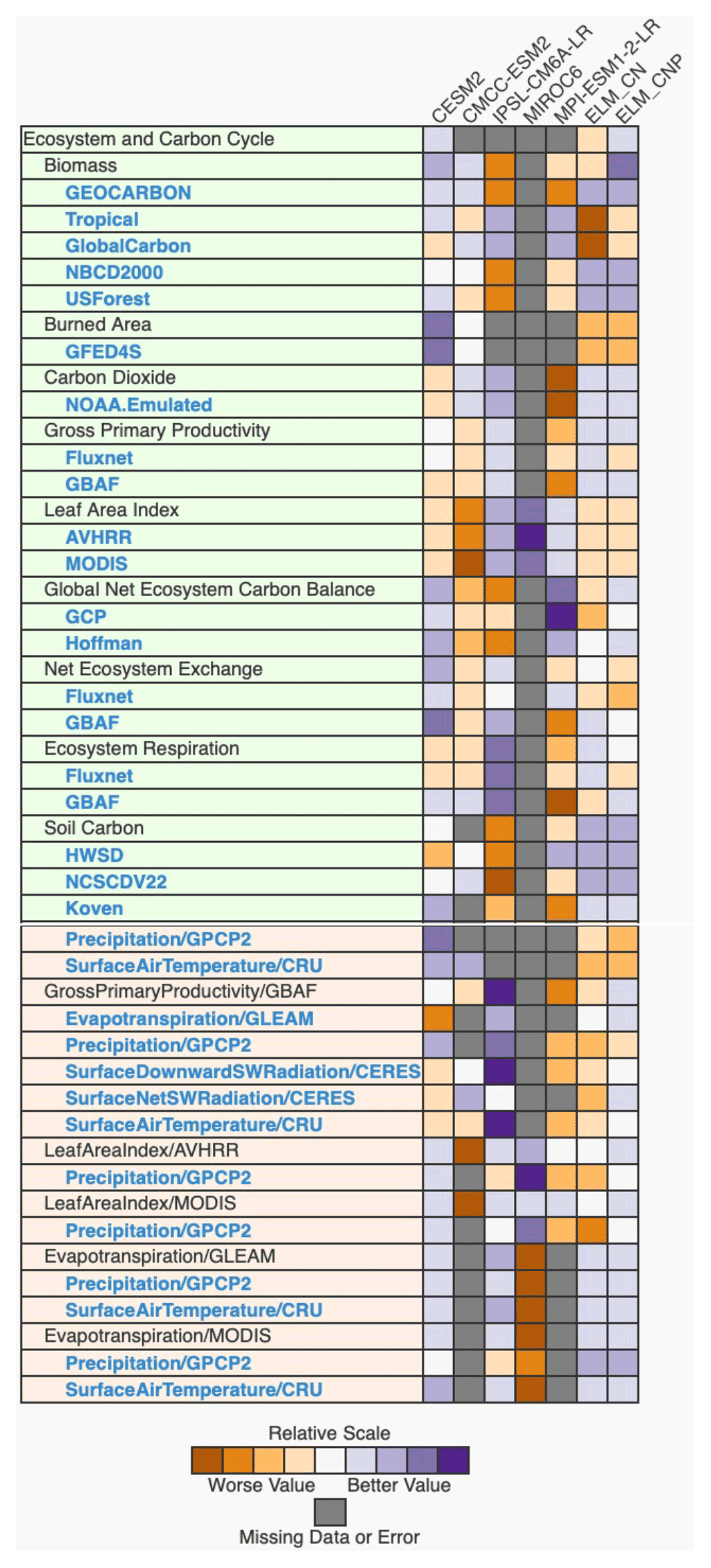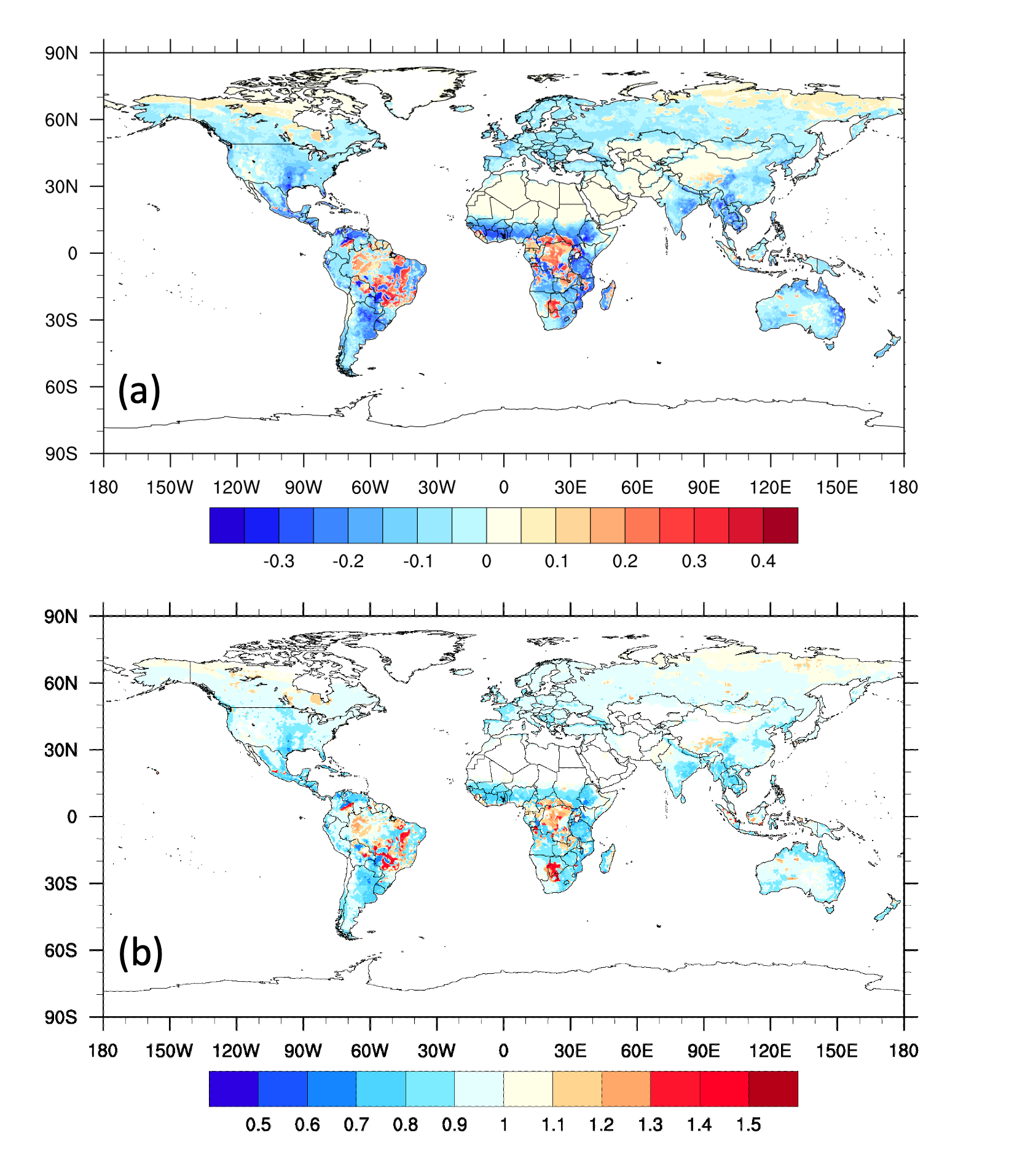Global Evaluation of Terrestrial Biogeochemistry in the Energy Exascale Earth System Model (E3SM)
This study investigates the role of the phosphorus cycle in the historical terrestrial carbon balance.
The Science
One of the major uncertainties for the prediction of the future net land–atmosphere carbon exchange relates to the representation of terrestrial biogeochemical cycles in Earth system models. This study provided a systematic evaluation of carbon (C), nitrogen (N) and phosphorus (P) cycling dynamics in the Energy Exascale Earth system Model (E3SM) on the global scale using both observational and experimental data. This study further quantified the role of P cycle dynamics and P limitation in affecting simulated C sources and sinks globally.

Figure 1. ILAMB carbon cycle scores for ELMv1-CNP and ELM-CN and a few land models in CMIP6. Shown here is the relative score, indicating the performance of each model relative to other models. References for benchmarking data for each variable are provided in the paper. The datasets that are in green boxes are either carbon pools or fluxes, while the datasets in orange boxes are relationships between carbon pools/fluxes and environmental variables such as precipitation or temperature. Outputs for other land models are from the LS3MIP offline simulations archive in CMIP6. These simulations were performed using the same resolution and forcing data as this study. CLM4.5 is the land model in CMCC-ESM2. CLM5 is the land model for CESM2. ORCHIDEE is the land model for IPSL. JSBACH is the land model for MPI-ESM1.2. VISIT is the land model for MIROC6.
The Impact
The results show that E3SM provides a reasonable representation of contemporary global-scale C, N, and P cycling dynamics. This study also demonstrates that the introduction of P cycle dynamics and C–N–P coupling have substantial consequences for projections of future C uptake. This study further highlights the data needs for global land model evaluation, particularly the need for more synthesis datasets on nutrient pools and fluxes.
Summary
Terrestrial ecosystems play important roles in taking up anthropogenic CO2 emissions. One of the major uncertainties for the prediction of the future net land–atmosphere carbon exchange relates to the representation of nutrient cycling and carbon-nutrient interactions in models.
The E3SM Land Model (ELM) was evaluated and compared to other models using the International Land Model Benchmarking (ILAMB) package which includes many metrics that cover water, energy, and carbon pools and fluxes on both regional and global scales. Figure 1 shows ILAMB benchmarking scores for ELMv1-CNP and ELMv1-CN, along with several other land models in CMIP6. For metrics in Figure 1 that show the greatest differences between ELMv1-CNP and ELMv1-CN, the CNP version always has a higher score than CN. This is reflected in the relatively higher aggregated scores for carbon cycle variables and functional relationships in ELMv1-CNP.

Figure 2. (a) The extent of nutrient limitation on plant growth. Blue color depicts regions that are more limited by N, while red regions are more limited by P. (b) Spatial variation of the ratios between P limitation and N limitation indicating the degree of co-limitation. Values close to 1 indicate NP co-limitation.
The performance of the land model in E3SM that includes both nitrogen (N) and phosphorus (P) limitation on carbon cycle processes is shown in Figure 2. The simulations suggest that in general, P is the more limiting nutrient in the tropical regions while N is more limiting in the middle to high latitudes. The results also indicate widespread N and P co-limitation, even in the tropical regions where P limitation is more dominant. Furthermore, global C sources and sinks are significantly affected by P limitation.
Publication
- Yang, Xiaojuan, Peter E. Thornton, Daniel M Ricciuto, Yilong Wang, and Forrest M Hoffman. 2023. “Global Evaluation Of Terrestrial Biogeochemistry In The Energy Exascale Earth System Model (E3Sm) And The Role Of The Phosphorus Cycle In The Historical Terrestrial Carbon Balance”. Biogeosciences 20: 2813–2836. doi:10.5194/bg-20-2813-2023.
Funding
- This work was supported by the Energy Exascale Earth System Model (E3SM) project of the Earth System Model Development program area of the Department of Energy, Office of Science, Biological and Environmental Research program.
Contact
- Xiaojuan Yang, Oak Ridge National Laboratory
This article is a part of the E3SM “Floating Points” Newsletter, to read the full Newsletter check:


